译林版牛津初中英语九年级下册全册单元知识点及语法整理
译林九年级英语下册知识点

译林九年级英语下册知识点一、语法知识点1. 一般现在时一般现在时表示经常性或习惯性的动作、状态或真理。
例句:- I often go for a walk in the park.我经常在公园散步。
- The sun rises in the east.太阳从东方升起。
2. 一般过去时一般过去时表示过去发生的动作或情况。
例句:- She lived in London for two years.她在伦敦住了两年。
- They went to the beach last summer.他们去年夏天去了海滩。
3. 现在进行时现在进行时表示现在正在进行的动作。
例句:- We are watching a movie right now.我们正在看电影。
- He is studying for the exam at the moment.他此刻正在为考试而学习。
4. 一般将来时一般将来时表示将来要发生的动作或存在的情况。
例句:- We will visit our grandparents next weekend.我们下周末会去看望祖父母。
- She is going to travel to Japan next month.她下个月将要去日本旅行。
5. 定语从句定语从句用来修饰一个名词,并且在句中担当定语的作用。
例句:- The book that I am reading is very interesting.我正在读的那本书非常有趣。
- The girl who won the competition is my friend.赢得比赛的那个女孩是我的朋友。
二、词汇知识点1. 动词短语固定动词短语是英语中常用的固定搭配,掌握这些短语可以丰富表达方式。
例句:- give up (放弃)She didn't give up easily and finally achieved her goal.她没有轻易放弃,最终实现了她的目标。
牛津译林版九年级9B下语法知识点

牛津译林版九年级9B下语法知识点语法是学习一门语言必不可少的一部分,它相当于一个词语和句子的拼图,帮助我们正确地表达意思。
牛津译林版九年级9B下的语法知识点内容丰富多样,包括时态、语态、虚拟语气、倒装等等。
在本文中,将分享一些重要的语法知识点以及相关的例子,帮助读者更好地理解和掌握。
时态是语法中一个非常重要的概念,它决定了动作发生的时间。
牛津译林版九年级9B下包括了一些常见的时态,如一般现在时、一般过去时、一般将来时等等。
下面,以一般现在时为例,介绍其基本用法。
一般现在时表示经常或者普遍发生的动作或状态。
在肯定句中,我们使用动词原形,而在否定句和疑问句中,则需要使用助动词do或does。
例如:肯定句:I go to school every day.(我每天去学校。
)否定句:She does not like apples.(她不喜欢苹果。
)疑问句:Do you play basketball?(你打篮球吗?)接下来,让我们来看一下语态的相关知识点。
语态表示动作的主语是被动地接受还是主动地执行。
在牛津译林版九年级9B下,我们学习了一般现在时的被动语态。
被动语态的结构是由be动词和动词的过去分词构成的。
例如:主动语态:They sell fruits in the market.(他们在市场上卖水果。
)被动语态:Fruits are sold in the market.(水果在市场上被卖。
)除了时态和语态,虚拟语气也是一个重要的语法知识点。
虚拟语气用于表达与事实相反或者不可能实现的情况。
牛津译林版九年级9B下学习了几个常见的虚拟语气形式,如与过去事实相反的虚拟语气、与现在事实相反的虚拟语气等等。
下面是一个例子:虚拟语气(与过去事实相反):If I were you, I would study harder.(如果我是你,我会更努力学习。
)最后一个要介绍的语法知识点是倒装。
倒装是将句子中的主语和谓语动词的位置颠倒,主要用于强调或者改变语气。
牛津译林英语九年级下册9BUnits1-4词组、句型、语法复习提纲

牛津译林英语九年级下册9BUnits1-4词组、句型、语法复习提纲9A Unit 1词组、句型及语法复习提纲一、词组或短语序号Chinese English1 有许多吃的和喝的(东西) have lots to eat and drink有许多值得庆祝的(事情)have a lot to celebrate2 为……担心worry about …= be worried about…某事使某人担心sth. worry sb.3 △(某人)对(……事物)很熟悉(sb.)be familiar with (sth.) (记住with后跟物)△……对(某人而言)很熟悉….be familiar to (sb.) (记住to后面跟人)4 △西方的文化Western culture(只要了解)5 对……有信心be confident of …. = have confidence in….6 学生会students’union7 被划分为12个星座be divided into 12 star signs8 有时at times = sometimes = from time to time9 一个勤奋的人 a hard-working person10 共同享有相似的特征share similar characteristics11 担心太多worry too much12 注意……pay attention to…13 (关于某事)与某人争吵 argue with sb. (about/over sth.)14 有许多精力have lots of energy15 保守秘密keep secrets16 因为某事而宽恕某人forgive sb. for sth.17 (富)有幽默感 have a (good) sense of humour18 到不同的地方去旅行travel to different places19 关心……care about …20 轻易放弃give up easily放弃某事(代词放中间) give sth. up放弃做某事give up doing sth.21 与某人交朋友/与某人做朋友make friends with sb./ be friends with sb.22 讲笑话tell jokes23 各种各样的……all kinds of…24 向某人解释某事explain sth. to sb.25 炫耀;卖弄show off26 梦到;梦见dream about ….梦到;梦见;梦想;渴望dream of…27 舞蹈课dancing lessons28 seem用法seem + adj. (系表结构)seem to do sth.It seems that + 宾语从句29 尽可能多的信息as much information as possible30 做某事遇到了难题/麻烦have problems/trouble/difficulty with sthhave problems/trouble/difficulty (in) doing sth.31 在学习或工作中取得成功have success at school or work32 最后finally = at last = in the end33 适合于……. be suitable for …..34 ★让某事被别人做(请别人做某事) have sth. done35开心地做某事have (lots of) fun (in) doing sth=have a good time (in) doing sth.= enjoy oneself (in) doing sth.36 提出;想到;拿出(新的主意) come up with (new ideas)37 A和B相似 A be similar to B38 推荐某人担….职务recommend sb. as +职务推荐某人获….奖recommend sb. for+奖项39 暑假作业summer homework40 得到满分get full marks41 给某人作演讲make/give a speech to sb.42 变得更加有条理/效率get more organized43 个人的才能(品质)personal qualities44 同意某人的意见agree with sb./what sb. said45 反对/介意(某人)做某事mind (one’s) doing sth. = mind ( sb.) doing sth.46 接受这份工作take this job47 记得做某事(还没做)remember to do sth.=don’t forget to do sth.记得做过某事(已做过)remember doing sth.48 暑假的剩余部分the rest of the summer holiday49 对某物感到好奇be curious about sth.50. 得病get sick51 大约在这个月中旬around the middle of the month二、重点句子及句型: 1.It’s nice of you to bring me the newspaper, Hobo.2.It says I’ll have lots to eat and drink today.3.You shouldn’t worry about not having breakfast then.4.A year is divided into 12 different star signs.5.Some people believe that people (born under the same star signs) share similar characteristics.6.You are patient and do not give up easily.7.You worry too much at times.8.You are practical and always pay attention to details.9.You love peace and do not like to argue with others.10.It is silly of you not to forgive others for their mistakes.lie finds maths [very difficult].12.You are patient enough to wait for a long time without getting angry.13.You like to dream about everything.14.Mr Wu spends a lot of time explaining things to us.15.This month, you will have a lot to celebrate.16. More details are available on request, please call Master Zhang on 55560678 if you want to know more.17.I may have problems with my health.★18.Peter has had his bicycle repaired.lie will have fun in cooking.20.He is imaginative enough to come up with new ideas.21.I’d like to recommend David as the new chairperson of the Students’ Union.22.We think that David has all the qualities (to be a good chairperson).三、语法:1. It is + adj. + of sb. +(not )to do sth. eg. It is kind/friendly/silly of you to do so. (此种句型中的形容词是指of 后的人所具备的性格特征或品行,如:friendly, kind, silly clever,careful , careless, selfish, generous , foolish等。
牛津译林版初中英语九年级上下册全册知识点归纳总结【推荐】

牛津译林版初中英语九年级上下册全册知识点归纳总结【推荐】牛津译林版初中英语九年级上册全册知识点归纳总结牛津初中英语9A_Unit1--Unit6知识点归纳牛津英语9A Unit 1一、重点词汇1.【小试牛刀】1. 十二点钟了,可他还是睡不着。
It was twelve o’clock, but he was still __________.2. 别弄醒这个孩子,他才睡着。
Don’t ___________ the boy. He fell asleep just now.二、语法点拨1. It is + adj + of sb. + (not) to do sth.It’s +adj.+of sb. to do sth.句型在英语中运用较为频繁,尤其在口语中。
该句型通常表示说话人对客观事件的惊讶、兴奋、懊悔、难过等感叹情绪,其实相当于感叹句。
如:It’s very kind of you to help me. 你能帮助我,真是太好了!该句型与how 引导的感叹句可以互换,故上句可以改为:How kind it is of you to help me ! 或How kind of you to help me !在口语中, it is经常被省略, 再如:It’s nice of you to say so.你这样说,真是太好了!可以省略为Nice of you to say so.当然此句改为You’re nice to say so.也可,意思不变。
有时也可用简缩句型It’s + adj.+ of sb. 或That’s + adj. + ofsb., 如:It’s wrong of you . 你错了!That’s lovely of her. 她多可爱呀!该句型中用作表语的形容词常见的有如下几类:(1) 表示聪明或愚蠢的形容词,有clever, wise, foolish, stupid, silly 等, 如:It’s silly of him to do such a thing. 他竟干出这样的事,真是愚蠢!(2) 表示正确或错误的形容词,有right, wrong, correct, incorrect 等, 如:It was right of her not to come here. 她没有来这儿,太对了!(3) 表示好坏等品性的形容词,此类词较多,有good, nice, kind, sweet, friendly, lovely等, 如:It’s friendly of you to come and see me. 你能来看我,真够朋友!(4) 表示褒义或贬义色彩的形容词,有brave, polite, careless, selfish等,如:It was brave of you to manage to do it. 你居然能做成这件事,真勇敢!【补充】of sb. 的句型通常都可转换为不定式作状语的句子。
牛津译林版九年级下册英语Unit 1-4知识点总结
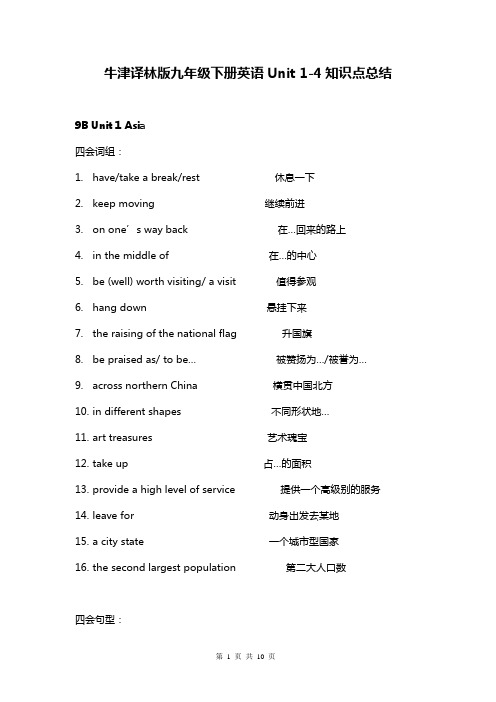
牛津译林版九年级下册英语Unit 1-4知识点总结9B Unit 1 Asia四会词组:1.have/take a break/rest 休息一下2.keep moving 继续前进3.on one’s way back 在…回来的路上4.in the middle of 在…的中心5.be (well) worth visiting/ a visit 值得参观6.hang down 悬挂下来7.the raising of the national flag 升国旗8.be praised as/ to be…被赞扬为…/被誉为…9.across northern China 横贯中国北方10.in different shapes 不同形状地…11.art treasures 艺术瑰宝12.take up 占…的面积13.provide a high level of service 提供一个高级别的服务14.leave for 动身出发去某地15.a city state 一个城市型国家16.the second largest population 第二大人口数四会句型:1.It’s tiring to climb the steps, and my feet hurt.爬台阶很累人,我的脚疼。
2.We had better keep moving.我们最好继续前进。
3.Thank you for your advice/ suggestion.谢谢你的建议。
4.With wonderful buildings and art treasures inside, it is well worth avisit.它里面有宏伟的建筑和艺术珍宝,非常值得一游。
5.It runs for over 6000 kilometres across northern China, with watchtowers every few hundred metres.6.它(长城)在中国北部地区绵延6000多公里,每隔几百米设有瞭望塔。
牛津译林版九下Unit1知识点总结梳理
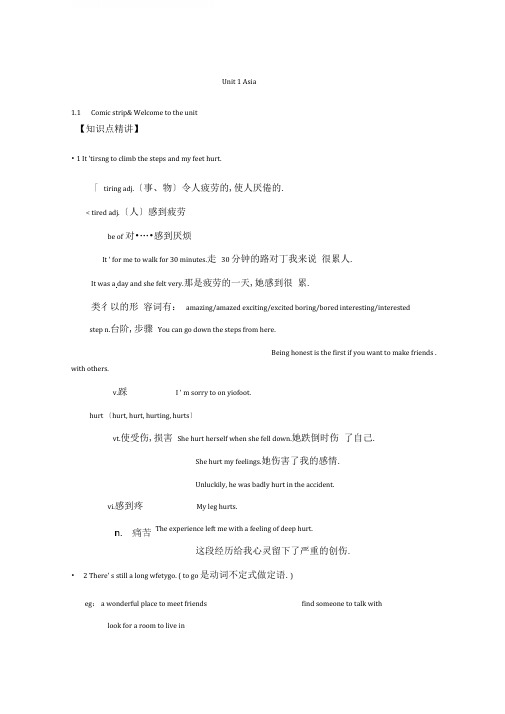
Unit 1 Asia1.1Comic strip& Welcome to the unit【知识点精讲】• 1 It 'tirsng to climb the steps and my feet hurt.「tiring adj.〔事、物〕令人疲劳的,使人厌倦的.< tired adj.〔人〕感到疲劳be of对•…•感到厌烦It ' for me to walk for 30 minutes.走30 分钟的路对丁我来说很累人.It was a day and she felt very.那是疲劳的一天,她感到很累.类彳以的形容词有:amazing/amazed exciting/excited boring/bored interesting/interestedstep n.台阶,步骤You can go down the steps from here.Being honest is the first if you want to make friends . with others.v.踩I ' m sorry to on yiofoot.hurt 〔hurt, hurt, hurting, hurts〕vt.使受伤,损害She hurt herself when she fell down.她跌倒时伤了自己.She hurt my feelings.她伤害了我的感情.Unluckily, he was badly hurt in the accident.vi.感到疼My leg hurts.The experience left me with a feeling of deep hurt.这段经历给我心灵留下了严重的创伤.• 2 There' s still a long wfetygo. ( to go 是动词不定式做定语.)eg: a wonderful place to meet friends find someone to talk with look for a room to live in1)He is always the first person(come) and the last one (leave ).2)There are many interesting books( choose ) from, but I don ' t know which to borrow.3)There is nothing(worry )about.• 3 We had better keep moving.①had better do sth.表示“最好做某事〞,表示劝告、建议或者愿望,否认形式是在had better后面加上not.例如:You' d better have a rest.You' d better not miss the last bus.②keep (on) doing sth意为“继续做某事、重复做某事〞.They kept talking about it.• 4 J go on to do 一事做完,接着做另一件事go on doing 事情暂停后继续做;一直做某事go on with后接名词或代词1)After a short break ,he went on(read) the rest of the text.2)After reading the novel , he went on(write) an article.• 5 wake v. (woke, waken, waking, wakes) adj. awakewake up your sister wake (me/him/her/them/you …)up• 6 Tian ' anmen Square, the Palace Museum and the Great Wall are wonderful places to go.to go这里是动词不定式作后置定语,修饰wonderful places.不定式作后置定语时,不定式与所修饰的名词之间往往有动宾关系, 如果不定式是不及物动词,动词不定式后面要加上必要的介词.We want some water to drink.He is a pleasant fellow to work with.1.2Reading【知识点精讲】• 1 In the middle of the ancient city of Beijing is the Palace Museum, also called the Forbidden City.①in the middle of表示“在...... 中间〞.What can you see in the middle of the picture?The teacher is standing in the middle of us.②called此处为动词的过去分词作定语,意为“被称为、被叫作〞,与named同义.例如:This is a book named/calledJourney to the WestThe Greens have a daughter named/called Kate.•2The emperors of the Ming and Qing dynasties used to live there.used to do sth.过去常常做某事〞,暗含现在不再〞之意,后接动词原形,疑问形式可以直接将used 提到句首,或者借助助动词did;否认式可以直接在used后面加not,或者用didn't【辨析】be /get used to doing sth., used to do sth.与be used to do sth.be /get used to doing sth. 习惯丁做某His father is used to watching TV before going to bed.事The boy used to play computer games.used to do sth. 过去经常做杲事More and more wood is used to make paperbe used to do sth.被用来做某事• 3 With wonderful buildings and art treasures inside , it is well worth a visit.①with复合结构" with+宾语+宾语补足语〞在句中作状语,表示伴随、原因、时间、条件、方式等.作宾语补足语的可以是形容词、名词、副词、介词短语、现在分词、过去分词或者动词不定式.He stood before his teacher with his head down.She said goodbye with tears in her eyes.He fell asleep with the lamp burning.I can ' t go out with all these clothes to wash.②be worth后常接名词或者动名词,表示“值...... 〞.The new car is worth at least 1 million.The novel is worth reading once more.• 4 Many tourists like to gather there early in the morning to watch the raising of the national flag.:rise raiserise 不及物动词上升〞The water in the river rose after the heavy rain. The sun rises in the east and sets in the west.rais e 及物动词E提升, 筹集,才口同, 举起〞The worker want the boss to raise their wages.The teacher asks us to raise our hands if we have questions.We should try our best to raise more money for the poor family.• 5 It is one of the wonders of the world.wonder作名词,意为“奇迹〞,常用的句型有:①It ' s a wonder that.为“奇怪的是 ........ 〞It ' s a wonder that she is still alive.②It 'no wonder that..点为“难怪 ....... 〞.It ' s no wonder that they won ' t come.【拓展】wonder用作及物动词,意为“想知道,对...... 好奇〞,常见的用法有:①后接who, what, why, where, when, how, which引导的宾语从句.She wondered what the child was doing.②后接if和whether引导的宾语从句.She wondered whether you were free that morning.③后接“疑问词+不定式〞构成的短语.I ' m just wondering how to do it.• 6 It lies on the two sides of the Lijiang River.动词lie表示“躺、位丁、撒谎〞lie 〔躺、位丁〕一lay 〔过去式〕一lain 〔过去分词〕-lying 〔现在分词〕lie 〔撒谎〕一lied 〔过去式〕一lied 〔过去分词〕-lying 〔现在分词〕lay 〔放置、下蛋〕一laid 〔过去式〕一laid 〔过去分词〕-laying 〔现在分词〕•7 ..some hang down, and others point upwards.①hang意为“悬:挂〞,过去式和过去分词都是hung, hang表示“上吊〞时,过去式和过去分词是hangedThis picture is hung on the wall.The man was hanged for murder.②point作动词,意为“指、指向〞常用的短语有point out"指出、指明〞;point to意为“指向〞,强调方向;point at表示指着某一个物体,指人时一般表示粗鲁或者不礼貌.He pointed to the door and there I saw a girl smiling at me.The teacher pointed at the map and told where Britain was.1.3Grammar【知识点精讲】• 1 The lake is very big -it takes up three quarters of the area.①take up意为“占据空间、占用时间〞.He has taken up a position in the centre of the room.I know how busy you must be and I wouldn ' t want to take up too much of your time.②quarter作名词,意为“四分之一〞.Three quarters of the students are boys.• 2 There are many tone lions on either side of it.either表示两者中的任何一个〞,做主语时,谓语动词常用单数形式,起其后可接of短语.You can come on Saturday or Sunday. Either is OK for me.We can't care much for what to eat. Either of the two will do.neither表示两者都不〞,做主语时,谓语动词常用单数形式,其后可接of短语. We have red and yellow Tshirts. Which color do you like?Oh, neither. I think blue will be OK.Neither of them wants to speak to him about this matter.• 3 They provide a high level of services .service作名词,意为“效劳〞,动词形式为serv&We all complain about the poor services of the hotel.Children must be educated to serve their country when they grow up.【语法精讲】代词it的用法1.it作人称代词的用法(1)指事物.it可指代除人以外的一切事物或动物.例如:—Where is the cat猫在哪?—It' s in the bedroom 它在卧室里.(2)指人.it可用丁指代性别不明的婴儿或用丁确认某人的身份.例如:Is it a boy or a girl?是男孩还是女孩?There is a knock on the door.It must be the postma^t人在敲门.一定是邮递员.(3)代替某些代词.it还可用丁代替指示代词this,that以及复合不定代词something,anything,nothing等.例如: —What' s this?®是什么?—It' s a present for you这是给你的礼物.2.it作非人称代词的用法.it主要用丁指代时间、距离、价值、天气、气候及温度等自然现象.例如:It' s 7 o' clock now.现在7 点钟.—How far is it from here to the station於里离车站多远?—It' s about two kilometres 大约两千米.3.it作形式主语或形式宾语的用法.(1)it作形式主语.当不定式、动名词、从句等成分作句子主语时,通常把真正的主语放在句末, 而在句首用it作形式主语.①It+be+adj.+for/of sb+to do sth 意为某人做某事......... 〞.例如:It is hard for him to make up his mind.他彳艮难下定决兀、.②It takes/took sb+寸问段+to do sth意为某人做某事花了多长时间〞.例如:It took me a month to get rid of my smoking 我花了一个月时间才把烟戒掉.③It is said/reported that..意为据说/据报道....... 〞.例如:It is said that he will study abroad 据说他要出国学习.(2)it作形式宾语.当不定式、动名词、从句等复杂成分作宾语,且其后跟有宾语补足语时,通常会在宾语补足语前用it作形式宾语,而将真正的宾语移至句末.其结构为生语+ 谓语+it+宾语补足语+不定式/动名词/从句〞.例如:I find it difficult to do the job well.我发现做好这项工作不容易.1.4Integrated skills &Study skills【知识点精讲】• 1 leaveJapan for another Asian country①Japan名词,意为“日本〞,其形容词形式Japanese意为“日本的〞,Japanese 还可表示“日本人〞,其复数形式和单数形式相同,为Japanese.He is from Japan.他来自日本.Here are some Japanese^ 儿是一些日本人.【拓展】其他一些单复数同形的单词:sheep?帛羊〕,deer 〔鹿〕,Chinese (中国人)• 2 looking down【拓展】含look的短语look down 俯视look after 照顾look at 看.....look back 回忆look for 寻找look forward to 盼望look into 调查look like看起来像look over 检查look in the eyes 注视look away转移目光How high the building is! I can' tLi Yan is such a helpful girl that she always my little sister while I ' maway.1.5Task&Self-assessment【知识点精讲】• 1 over one billion, the second largest population in the world.population表示“人口〞,是集合名词,对人口数量提问时,用what而不用how many/much, population 假设作主语,强调整体概念时,谓语用单数形式,强调个体时,谓语用复数形式.What' s the population in China now?The population of this small town is three thousand.More than one fifth of the population of the country are over 60 years old.【拓展】1〕population常与定冠词the连用,作主语用时,谓语动词常用第三人称单数形式.The world's population increasing faster and faster.世界的人口增长得越来越快.At the beginning of the twentieth ce ntury, the world's population was about 1,7 billion.在二十世纪初,全世界的人口大约是十七亿.2〕当主语是表示〞人口的白分之几、几分之几"时,谓语动词用复数形式.About seventy percent of the population in China farmers.中国大约有白分之七十的人口是农民.3〕有时population可用作可数名词,其前可用不定冠词.China has a population of about 1.3 billion.(=There is a population of about 1.3 billion in China.)中国大约有十三亿人口.New York is a big city with a population of over 10 million.纽约是一个有一千多万人口的大城市.4)表示人口的"多"或"少",不用"much"或"little",而要用"large"或"small".India has a large population.印度人口众多.Singapore has a small population.新加坡人口少.5)询问某国、某地有多少人口时,不用"How much...?〞,而用〞How large...?";在问具体人口时用〞What...?〞.-How is the population of your hometown?你们家乡有多少人口?-The population of our hometown is nearly twice as large as that of yours.我们家乡的人口是你们家乡人口的将近两倍.-is the population of Canada?加拿大的人口有多少?-The population of Canada is about 29 million.加拿大的人口大约有二千九K万.• 2 famous for IT(information technology) industry.be famous for sth. “因 ...... 而知名〞The writer is famous for his novels.be famous as “作为..... 而知名〞The man is famous as a novelist.。
译林版牛津初中英语九年级下册全册单元知识点及语法整理
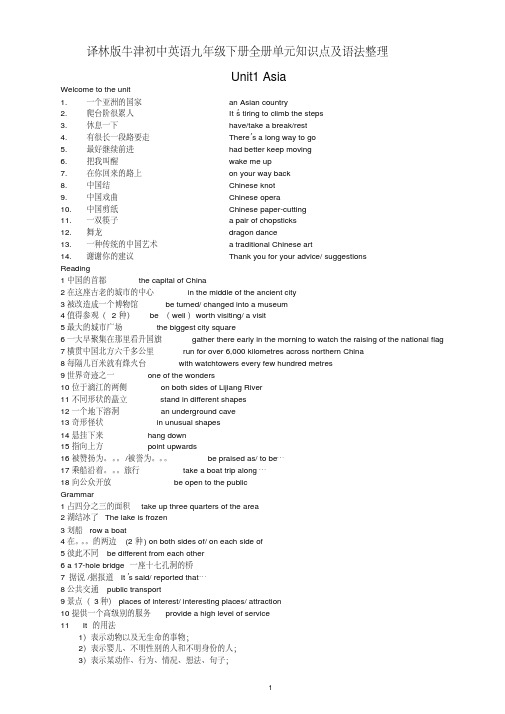
译林版牛津初中英语九年级下册全册单元知识点及语法整理Unit1 AsiaWelcome to the unit1.一个亚洲的国家an Asian country2.爬台阶很累人It’s tiring to climb the steps3.休息一下have/take a break/rest4.有很长一段路要走There’s a long way to go5.最好继续前进had better keep moving6.把我叫醒wake me up7.在你回来的路上on your way back8.中国结Chinese knot9.中国戏曲Chinese opera10.中国剪纸Chinese paper-cutting11.一双筷子 a pair of chopsticks12.舞龙dragon dance13.一种传统的中国艺术 a traditional Chinese art14.谢谢你的建议Thank you for your advice/ suggestionsReading1中国的首都the capital of China2在这座古老的城市的中心in the middle of the ancient city3被改造成一个博物馆be turned/ changed into a museum4值得参观(2种)be (well)worth visiting/ a visit5最大的城市广场the biggest city square6一大早聚集在那里看升国旗gather there early in the morning to watch the raising of the national flag 7横贯中国北方六千多公里run for over 6,000 kilometres across northern China8每隔几百米就有烽火台with watchtowers every few hundred metres9世界奇迹之一one of the wonders10位于漓江的两侧on both sides of Lijiang River11不同形状的矗立stand in different shapes12一个地下溶洞an underground cave13奇形怪状in unusual shapes14悬挂下来hang down15指向上方point upwards16被赞扬为。
译林牛津版九年级下册英语全册知识点归纳总结(Word版)

译林牛津版九年级下册英语全册知识点归纳总结(Word版)1. 词汇部分在译林牛津版九年级下册英语中,词汇可是相当重要的一部分呢。
先看第一单元的重点单词“success”,它是名词,意思是成功。
用法上,我们可以说“achieve success”取得成功。
搭配有“success in sth/doing sth”,像“He had great success in passing the exam”。
同根词有“successful”形容词,“successfully”副词,例如“The man successfully finished the difficult task and became a successful businessman”。
还有“suggest”这个词,动词,意思是建议。
它的用法是“suggest doing sth”,比如“I suggest going for a walk”。
它的搭配“suggest sth to sb”,“suggest that sb (should) do sth”。
易混淆的单词是“advise”,“advise”后面接“sb to do sth”,而“suggest”没有这种用法。
再看“pollute”,动词,污染的意思。
“pollution”是它的名词形式。
用法如“Air is polluted by factories”。
搭配“pollute sth with sth”。
易混淆的是“contaminate”,不过“contaminate”更多指化学物质等的污染,程度可能更深。
“create”,动词,创造。
用法“create sth”,例如“create a new world”。
同根词“creative”,形容词,有创造力的。
易混淆的单词“invent”,“invent”侧重于发明以前没有的东西,而“create”更广泛,可以是创造一种氛围等。
译林牛津九年级英语知识点

译林牛津九年级英语知识点一、1. 语法知识点在九年级英语学习中,学生会接触到以下语法知识点:(1) 直接引语和间接引语(2) 情态动词(3) 条件句和虚拟语气(4) 状语从句(5) 定语从句(6) 名词性从句(7) 宾语从句(8) 主语从句(9) 动词的时态和语态(10) 句型转换2. 单词和词组九年级英语学习中,学生需要掌握各种单词和词组,如:(1) 各类常用动词、名词、形容词等(2) 介词短语(3) 常见的短语动词(4) 数词和量词(5) 形容词和副词的比较级与最高级(6) 并列连词和转折连词3. 句型结构在九年级英语学习中,学生需要掌握各种句型结构,如:(1) 祈使句(2) 肯定句和否定句(3) 一般疑问句和特殊疑问句(4) 句子强调结构(5) 句子倒装结构4. 阅读技巧阅读技巧:(1) 理解文章主旨(2) 掌握推理判断能力(3) 学会查找关键词(4) 了解词义的猜测(5) 注意文章结构和段落(6) 阅读速度的控制(7) 总结、归纳和整理信息5. 写作技巧写作技巧:(1) 利用课堂学习的语法知识进行表达(2) 合理运用各种句型和词汇(3) 注意句子及段落之间的衔接关系(4) 注意使用恰当的过渡词和短语(5) 注意语法的准确性和连贯性(6) 善于运用写作模板和范文进行练习(7) 多读、多写、多积累范文和素材二、总结通过对九年级英语的知识点进行归纳和总结,可以清晰地了解到九年级英语学习的要点。
在学习过程中,需要掌握语法知识点、单词和词组、句型结构、阅读技巧以及写作技巧等方面的内容,通过积极学习和实践来提高自己的英语水平。
希望同学们能够认真学习、灵活运用,并通过不断练习和实践,取得优异的成绩。
加油!。
Unit 1--2知识点归纳牛津译林版英语九年级下册
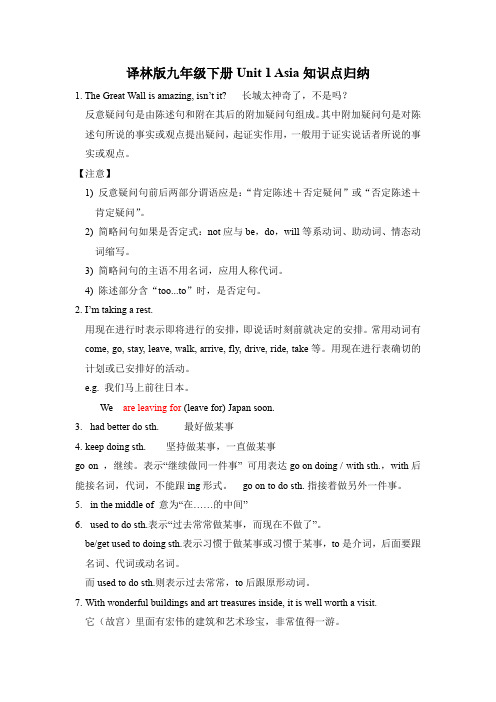
译林版九年级下册Unit 1 Asia知识点归纳1. The Great Wall is amazing, isn’t it? 长城太神奇了,不是吗?反意疑问句是由陈述句和附在其后的附加疑问句组成。
其中附加疑问句是对陈述句所说的事实或观点提出疑问,起证实作用,一般用于证实说话者所说的事实或观点。
【注意】1) 反意疑问句前后两部分谓语应是:“肯定陈述+否定疑问”或“否定陈述+肯定疑问”。
2) 简略问句如果是否定式:not应与be,do,will等系动词、助动词、情态动词缩写。
3) 简略问句的主语不用名词,应用人称代词。
4) 陈述部分含“too...to”时,是否定句。
2. I’m taking a rest.用现在进行时表示即将进行的安排,即说话时刻前就决定的安排。
常用动词有come, go, stay, leave, walk, arrive, fly, drive, ride, take等。
用现在进行表确切的计划或已安排好的活动。
e.g. 我们马上前往日本。
We are leaving for (leave for) Japan soon.3.had better do sth. 最好做某事4.keep doing sth. 坚持做某事,一直做某事go on ,继续。
表示“继续做同一件事” 可用表达go on doing/ with sth.,with后能接名词,代词,不能跟ing形式。
go on to do sth.指接着做另外一件事。
5.in the middle of 意为“在……的中间”ed to do sth.表示“过去常常做某事,而现在不做了”。
be/get used to doing sth.表示习惯于做某事或习惯于某事,to是介词,后面要跟名词、代词或动名词。
而used to do sth.则表示过去常常,to后跟原形动词。
7.With wonderful buildings and art treasures inside, it is well worth a visit.它(故宫)里面有宏伟的建筑和艺术珍宝,非常值得一游。
牛津译林九年级语法知识点
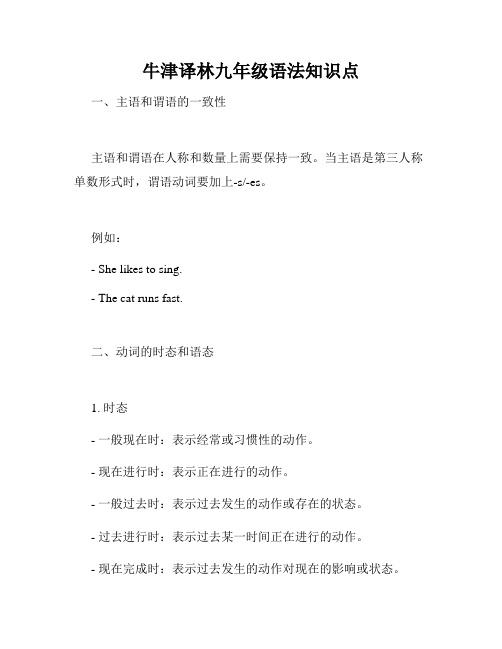
牛津译林九年级语法知识点一、主语和谓语的一致性主语和谓语在人称和数量上需要保持一致。
当主语是第三人称单数形式时,谓语动词要加上-s/-es。
例如:- She likes to sing.- The cat runs fast.二、动词的时态和语态1. 时态- 一般现在时:表示经常或习惯性的动作。
- 现在进行时:表示正在进行的动作。
- 一般过去时:表示过去发生的动作或存在的状态。
- 过去进行时:表示过去某一时间正在进行的动作。
- 现在完成时:表示过去发生的动作对现在的影响或状态。
- 过去完成时:表示过去某一时间或动作发生之前已经完成的动作。
- 将来时:表示将来要发生的动作或存在的状态。
例如:- They play basketball every Sunday. (一般现在时)- He is studying in his room. (现在进行时)- She went to the park yesterday. (一般过去时)- They were having dinner when I arrived. (过去进行时)- I have finished my homework. (现在完成时)- By the time I arrived, they had already left. (过去完成时)- We will visit Beijing next month. (将来时)2. 语态- 被动语态:表示动作的承受者或行为的重点在于动作本身,而不是做动作的人。
- 主动语态:表示动作的执行者或行为的重点在于做动作的人。
例如:- The book was written by him. (被动语态)- He wrote the book. (主动语态)三、名词性从句名词性从句充当句子的主语、宾语、表语和同位语等,引导名词性从句的词有:that, whether, if, who, whom, which, whose, what, how, when, where等。
九年级下册英语译林知识点

九年级下册英语译林知识点一、时态1. 一般现在时:表示经常、通常或普遍存在的情况。
2. 现在进行时:表示现在正在进行的动作或情况。
3. 一般过去时:表示过去某个时间发生的动作或存在的状态。
4. 过去进行时:表示过去某个时间正在进行的动作。
5. 将来时:表示将来某个时间将要发生的动作或存在的状态。
二、语法点1. 定语从句:修饰名词或代词的从句。
2. 名词性从句:作主语、宾语、表语或介词宾语的从句。
3. 倒装句:将谓语动词的全部或一部分移到主语之前。
4. 强调句:通过强调特定部分来表达强调的语气。
5. 被动语态:表示动作的承受者(或行为执行者)时使用。
三、阅读技巧1. 预测:通过题目、文章首句等信息猜测文章内容。
2. 略读:快速阅读文章,了解大意。
3. 扫读:快速寻找特定信息或答案。
4. 详读:仔细阅读文章,理解细节和推理出结论。
5. 标记关键词:用笔或标记工具标记文章中的关键词,便于整理和复习。
四、写作技巧1. 书信写作:包括称呼、开头、主体、结尾等组成部分。
2. 日记写作:按照时间顺序写出当天的所见、所想、所做等内容。
3. 演讲写作:包括开场白、主体内容和结尾等部分,要注意语言表达和条理清晰。
4. 推荐信写作:介绍被推荐人的个人情况、能力和优点等。
5. 简报写作:简明扼要地陈述事实、数据和结论等。
五、词汇积累1. 动词短语:通过动词和副词或介词短语的搭配学习常用的动词短语。
2. 名词短语:通过名词和介词或形容词的搭配学习常用的名词短语。
3. 介词短语:通过介词和名词短语或动词短语的搭配学习常用的介词短语。
4. 形容词短语:通过形容词和名词短语或副词的搭配学习常用的形容词短语。
5. 副词短语:通过副词和名词短语或形容词的搭配学习常用的副词短语。
六、交际用语1. 问路:如询问去某个地方的路线、交通方式等。
2. 邀请:如邀请朋友参加聚会、活动等。
3. 自我介绍:如介绍自己的姓名、年龄、兴趣等。
4. 道歉:如因自己的错误或过失向他人道歉。
译林牛津版九年级下册英语全册知识点归纳总结(Word版)

译林牛津版九年级下册英语全册知识点归纳总结(Word版)新译林9B 英语全册知识点归纳总结9B UNIT 1 一、词汇大集合1. It says 上面写着,上面显示2. eat up 吃光,吃完(use up 用完,用尽)(代词的位置)3. be well organized 很有条理的4. keep ........ in good order使... 保持井然有序(in order按顺序)5. show off 炫耀,卖弄(show sb around sp 带领某人参观某地show sb the way to 给某人指到某地的路)6. show no interest in 对.. 毫不感兴趣7. repeat grammar rulers for us 为我们重复语法规则8. come up with (= think of 想出,提出);追上,赶上9. be curious about对…感到好奇10. get angry easily 容易生气(anger n.)11. make a good accountant 成为一名优秀的会计12. neither ....... nor ........ 既不... 也不.... (就近原则)Neither he nor I am well educatedeither ...... or ......... 或者 ... 或者.....both …… and ……两者都连接两个主语时,谓语动词用复数形式13. He didn ' t come here yesterday , neither / nor did I 他昨天没来这儿,我也是* * * 拓展:so, neither 位于分句或句子的开头,这种结构通常表示前面所说的情况也适合于另一个人(或事物),表示“我也这样”之类的概念。
* * *其句型可归纳为:so / neither + be / have / 助动词/ 情态动词+ 主语。
译林版九年级下学期全册知识点梳理

九下第一单元知识点梳理1.tiring (adj.使人疲劳的,累人的)→ tired (adj.疲倦的;困倦的)→ tire (v.使疲劳)2. raising (n.升高)→ raise (v.举起,提起;筹集;饲养)3. attraction (n.向往的地方:吸引)- attract(v.吸引)→ attractive (adj.有吸引力的;漂亮的)4. wonder(n.奇迹)→ wonderful(adj.精彩的)→ wonderfully(adv.精彩地)5. eastern (adj.东部的,东方的)→ east(n.东,东方)6. service (n.服务;工作)→ serve(v.服役;招待;服务)7. Japanese (n&adj.日本(人)的)→ Japan(n.日本)8. Indian (n&adj.印度(人)的)→ India(n.印度)1.climb the steps 爬台阶2.take a rest 休息一下3. on your way back 在你回来的途中4. in the middle of 在……中间5. watch the raising of the national flag 观看升国旗6. in a natural landscape 在自然景观中7. every few hundred metres 每隔几百米8. the wonders of the world 世界奇迹9. lie on the two sides of 位于……两边10.stand in different shapes 以不同形状耸立着11. hang down 向下悬垂12. be praised as ...被誉为……13. take a boat trip along ...坐船沿……游览14. hire a bicycle 租一辆自行车15. take up 占据(空间);占用(时间)16. three quarters of ...……的四分之三17.a 17-hole bridge 一座十七孔的桥18. provide a high level of service 提供高水平的服务19. an ancient city of culture 一座文化古城20. take a tour of ...参观/游览……21. be well worth a visit 非常值得参观22.main crops 主要作物23. a large iron and steel industry 大型钢铁工业1. It's tiring to do sth.做某事是累人的2. keep doing sth.继续/重复做某事3. on one's way back 在某人返回的路上4.Why don't you ...?你(们)为什么不……?5. used to do sth.过去常常做某事6. turn ...into...把……变成……7. on either side of ...在……的任一边8. be worth doing sth.值得做某事9. three quarters of ...……的四分之三10.think/find it + adj+ to do sth.认为/发现做某事是……的11. It's + adj,+ for sb. to do sth.对某人来说做某事是……的12. It's said that ...据说……13, leave for sp.动身去某地14.The population of……的人口15.It lies in 位于……九下第二单元知识点梳理一·词形拓展1. invent (vt.发明)→ inventor (n.发明者)→ invention (n.发明物;创意)2.explorer (n.探险者;考察者)→ explore(vt.探索;探讨)3.South African (n.南非人)→ South Africa(n.南非)4. fighter(n.斗士,战斗者;战斗机)→ fight (v.战斗;打架)5. Italian(n.意大利人)→ Italy(n.意大利)6. European(n.欧洲人)→ Europe(n.欧洲)7. Russian (n.俄罗斯人)→ Russia(n.俄罗斯)8. serve (vi.&vt.服役;服务,招待)→ service (n.服务;工作)9. further (adj.更多的,更进一步的)→ far (adj.远的)10. citizen (n.公民;市民)→city(n.城市)11. pride(n.骄傲;可引以为豪的人(或物)(→ proud (adj.骄傲的,自豪的)12. scientist (n.科学家)→ science (n.科学)13. discovery (n.发现;发现物)→ discover (v.发现)14. unknown (adj.未知的;不出名的)→ known (adj.已知的;出名的)15. widely (adv.广泛地,普遍地)→ wide (adj.宽的,宽阔的)16. hunger (n.饥饿)→ hungry (adj.饥饿的)17.advantage (n.优势,有利条件)→ disadvantage (n.劣势,不利条件)18. production (n.生产;产量)→ produce(v.生产)19. development (n.发展)→ develop(v.发展)→ developing (adj.发展中的)→ developed(adj.发达的)二·短语总结1. South African 南非人2. create over 1,000 inventions 创造了1 000 多项发明3. become interested in flying 对飞行感兴趣4. join the navy 参加海军5. go into space 进入太空6.cut ... short 缩短7. step out onto the Moon's surface 跨出走到月球的表面8. for further research 为了更进一步的研究9. by hand 手工10. not one's cup of tea (口语)非某人所爱11. die of hunger 死于饥饿12. at the age of ...在……岁时13. manage to do sth.设法做成某事14 together with sb.和某人一起15.marry sb.与某人结婚be/ get married to sh.与某人结婚16.push for the use of 推动使用……17.have advantages over 有胜于……的优势18. That's why ....那就是……的原因。
牛津译林版英语九年级下册 单元复习要点总结1-4

9B 单元复习要点(Unit 1)一、词形变化tired—tiring wonder—wonderfulattract—attraction—attractivelie—lay—lain hang—hung—hungeast—eastern south—southernnorth—northern serve—service二、重要短语Chinese knot 中国结Chinese opera 中国戏曲Chinese paper—cutting 中国剪纸dragon dance 舞龙in the middle of----在……中间by underground 乘地铁take an underground 乘地铁take up 占据either ---or---或者……或者,不是……就是on one’s way to ---在某人去……的路上keep moving 不停地移动take/ have a rest 休息一会儿exchange students 交换留学生travel around China 游遍中国a wonderful place to go 一个好去处traditional Chinese art 传统的中国艺术Beijing Opera 京剧welcome to ----欢迎到……used to do 过去常做be used to do 被用来做be used to sth/ doing 习惯于……turn ---into--- 把……变成……be well worth a visit 值得参观=be well worth visitingwatch the raising of the national flag观看升国旗across northern China 横贯中国北部in southern China 在中国南部=in the south of China=in the southern part of Chinahand down 向下悬垂be open to the public 对公众开放three quarters 四分之三=three fourthson either side of---在任何一边(两边)=onleave (----) for----(离开……) 去……feel a bit/ little cold 觉得有点冷at noon 在中午public transport 公共交通get around 观光provide a high level of service提供高品质的服务works of art 艺术品during our stay in Japan在我们待日本期间an ancient city of culture 一座文化古城take a tour of ----参观,游览……the wonders of the world 世界奇迹be praised as ----被誉为……every few hundred metres 每隔几百米a 17-hole bridge 一座十七孔洞的桥a large iron and steel industry大型钢铁工业communicate with sb 和某人交流take a coach 乘长途汽车by coach 乘长途汽车both sides of----/ on each side of---the Great Wall 长城the Summer Palace 颐和园the Palace Museum 故宫early in the morning 一大早,清晨take a boat trip 乘船旅行around the countryside 郊区in the past 在过去at present 现在go skiing / skating 去滑冰/ 去滑雪all kinds of ----各种各样的三、重要语言点It 的用法1. 表示动物以及无生命的事物;2. 表示婴儿、不明性别的人和不明身份的人;3. 表示某动作、行为、情况、想法、句子;4. 表示时间、日期、天气、距离、自然现象等;5. 作形式主语和形式宾语;6. 固定短语中:take it easy 别紧张,别着急make it 做到,办成believe it or not 信不信由你7. 含it 的常见句型①It is + 形容词for sb to do sth②It is + 形容词of sb to do sth③---find/ make/ think it +形容词+ to do sth④It is +形容词/ 名词+ that 从句⑤It is + 被强调部分+who/ that + ----⑥It is because + 从句⑦It is time to do sth ./ It’s time for sth .是做某事的时间了。
牛津译林版九年级知识点

牛津译林版九年级知识点一、英语语法知识1. 时态:牛津译林版九年级英语学习中,时态是一个非常重要的知识点。
牛津译林版本教材中涵盖了多种时态,如一般现在时、一般过去时、一般将来时等。
学生需要掌握各种时态的构成和用法。
2. 句子结构:掌握英语句子的基本结构是学习英语语法的关键。
学生需要了解主谓宾结构以及不同句子类型的构成,如陈述句、疑问句、祈使句等。
3. 名词:学生需要学习名词的单复数形式、所有格和不同类型名词的用法,如可数名词和不可数名词。
4. 代词:掌握代词的用法是英语学习的基础。
学生需要了解主格、宾格、形容词性物主代词和名词性物主代词的用法。
5. 形容词和副词:学生需要学习形容词和副词的比较级和最高级形式,并能正确运用于句子中。
6. 介词:掌握介词的正确用法对学生的语言运用能力至关重要。
学生需要学习常见的介词用法,如in、on、at等。
7. 从句:学生需要学习条件状语从句、时间状语从句和同位语从句的构成和用法。
二、词汇积累1. 同义词和反义词:学生需要通过阅读教材中的文章来扩充词汇量,特别是一些常见的同义词和反义词。
2. 词汇记忆:学生需要通过各种方法来记忆生词和短语,如使用记忆卡片、创造语境、多次重复等。
3. 词汇运用:学生需要通过做各种练习题来巩固和应用所学的词汇。
三、阅读理解1. 阅读技巧:学生需要学习阅读理解的基本技巧,如快速浏览、重点阅读和理解文章的主旨等。
2. 阅读篇章:学生需要通过阅读篇章和文章来提高理解能力和阅读速度。
3. 题型分析:学生需要了解不同题型的要求和解题方法,如判断正误、选择正确答案、回答问题和填空等。
四、写作技巧1. 写作结构:学生需要学习如何合理组织和安排文章结构,包括开头、中间段落和结尾等。
2. 语言表达:学生需要学习如何用准确、流利和连贯的语言表达自己的观点和想法。
3. 写作练习:学生需要通过写作练习来提高写作能力,如写信、写日记、写作文等。
以上是牛津译林版九年级英语教材中的一些重要知识点,学生们需要通过课堂学习和课后练习来掌握这些知识点。
牛津译林九年级下册词汇和短语梳理
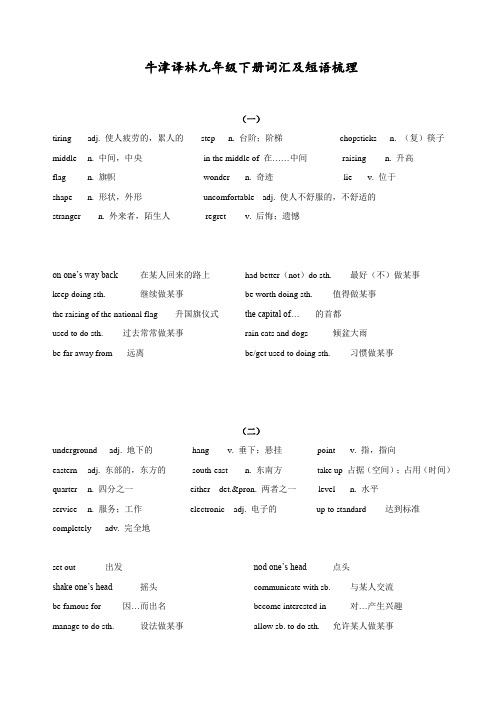
牛津译林九年级下册词汇及短语梳理(一)tiring adj. 使人疲劳的,累人的step n. 台阶;阶梯chopsticks n. (复)筷子middle n. 中间,中央in the middle of 在……中间raising n. 升高flag n. 旗帜wonder n. 奇迹lie v. 位于shape n. 形状,外形uncomfortable adj. 使人不舒服的,不舒适的stranger n. 外来者,陌生人regret v. 后悔;遗憾on one’s way back 在某人回来的路上had better(not)do sth. 最好(不)做某事keep doing sth. 继续做某事be worth doing sth. 值得做某事the raising of the national flag 升国旗仪式the capital of…的首都used to do sth. 过去常常做某事rain cats and dogs 倾盆大雨be far away from 远离be/get used to doing sth. 习惯做某事(二)underground adj. 地下的hang v. 垂下;悬挂point v. 指,指向eastern adj. 东部的,东方的south-east n. 东南方take up 占据(空间);占用(时间)quarter n. 四分之一either det.&pron. 两者之一level n. 水平service n. 服务;工作electronic adj. 电子的up to standard 达到标准completely adv. 完全地set out 出发nod one’s head 点头shake one’s head 摇头communicate with sb. 与某人交流be famous for 因…而出名become interested in 对…产生兴趣manage to do sth. 设法做某事allow sb. to do sth. 允许某人做某事out of control 失去控制make a great difference 有很大区别(三)Japanese adj. 日本(人)的state n. 国家;州population n. 人口technology n. 技术fair n. 集市;庙会;展览会Indian adj. 印度(人)的at present 现在,目前increase v. 增加development n. 发展carry out 开展;执行risk n. 风险,危险after all 毕竟have time to do sth 有时间做某事practice doing sth. 练习做某事get married 结婚believe it or not 信不信由你graduate…from…从…毕业complain to sb. about sth. 向某人就某事投诉in order to have more spare time 为了有更多的业余时间What should he do with the robot? 他应该如何处理这机器人?find out the causes of the problems 发现问题的原因need checking every 6 months 需要每6个月检修(四)inventor n. 发明者invent v. 发明South African 南非人fighter n. 斗士,战斗者;战斗机invention n. 发明物;创意European n. 欧洲人Russian n. 俄罗斯人pilot n. 飞行员serve v. 服役;服务,招待test n. 测试;检验circle v. 围绕;将……圈起来agreement n. 一致,同意possibility n. 可能性a long way to go 有一段长路要走continue to the end 坚持到底watch the raising of the national flag 观看升国旗go on holiday to Japan = go to Japan for a holiday 去日本度假gather here early in the morning一清早聚集在这儿experience its beauty and greatness体验它的美丽和宏伟stand in different shapes 以不同的形状耸立着wonderful rocks in strange shape奇形怪状的美妙的岩石Chinese paintings of the landscape 中国水墨风景画consist of ...... .= be made up of ...... 由......组成;包括......(五)control n. 控制,支配out of control 失去控制,无法管理order n. 命令,指挥,要求cut ... short 缩短Pacific adj. 太平洋的land v. (使)着陆,(使)降落step v. 走,跨步(vi)surface n. 表面;表层further adj. 更多的,更进一步的pride n. 骄傲;可引以为豪的人(或物)compare v. 比较compare to/with 与……相比rapidly adv. 快地,迅速地There is no need to do sth. 没有必要做事;不需要做某事be filled with = be full of 被装满了……make the bed 整理床铺explore dangerous places 探测危险的地方change one's life a lot 改变某人的生活许多be happy / pleased / satisfied with 对……满意go wrong 出毛病,走错路catch a virus 染上病毒fall to the ground 掉到地上make a mess 搞成一团糟(六)passage n. 章节,乐段by hand 手工mathematics n. 数学(=maths)scientist n. 科学家laboratory n. 实验室(=lab)discovery n. 发现;发现物unknown adj. 未知的;不出名的widely a dv. 广泛地,普遍地happen to 碰巧advantage n. 优势,有利条件in the form of 以……的形式tasty adj. 味道好的specially adv. 专门的,特地throw sth. into sp.along with sth. 把……和……一道扔进……里keep my flat as clean as new 保持我的公寓和新的一样干净last for= go on for 持续…… expect sb. to do sth. 期盼某人做某事look forward to doing sth. 盼望做某事hear from sb. =get a letter from sb. =receive a letter from sb. 收到某人来信get to my food 够到我的食物in the form of pills 呈现药片的形状make sb. calm down 使某人镇定下来provide sb. with sth. = provide sth. for sb 提供某物给某人.(七)robot n. 机器人post v. 邮寄(英)product n. 产品,成果brain n. 大脑whatever pron. 任何,一切事物order v. 订购smoothly adv. 平整地;顺利地in general 总的来说;大体上satisfy v. 满足,使……满意need n. 需要的事物;欲望(all) over again 再;重新passenger n. 乘客at a/the speed of 以……的速度become more and more crowded 变得越来越拥挤travel at half the speed of light 以光速的一半运行float away into space 漂入太空中take exams 进行考试a s tasty as …和…….一样美味do harm to sb. = harm sb. 伤害某人the journey to Mars 去火星的旅行on the surface of Earth 在地球的表面under the control of computers 在电脑的控制下start with…= begin with…以…….开始(八)no longer 不再properly adv. 正确地,适当地complete adj. 完全的,彻底的mess n. 乱七八糟lay v. 放,搁store v. 储藏,存储coin n. 硬币bill n. 账单private adj. 私人的paper n. 文件,证明polluted adj. 被污染的rapid adv. 快地,迅速地increase v. 增加worry about (doing) sth.= be worried about (doing) sth. 担心(做某事)keep sb. away from ….让某人远离…….It takes sb. some time to do sth. 花费某人一些时间做某事keep/stop/prevent sb. from doing sth. 阻止某人做某事take high-quality images 拍高质量的图片have lots of memory space 有许多存储空间be stored for many months 被储存很多个月the least important 最不重要的take the place of …代替…….(动词短语)sit by the window 坐在窗户旁边(九)spread v.(使)散开;扩散wheel n. 轮子,车轮unsure adj. 不确定,没把握customer n. 消费者,顾客hold v. (打电话时)等待,不挂断through adv. (电话)接通put through 给……接通(电话)satisfied adj. 满意的,满足的be satisfied with 对……感到满意first of all 首先dried food 干粮sleeping bag 睡袋planet n. 行星a guide to living on Mars in 2100 2100年火星生活指南prefer to do sth. 更喜欢做某事take off 起飞There will be various designs for settlers to choose from. 会有各种款式供移民挑选compared with life on Earth . 与地球上的生活相比The population is still increasing quickly. 人口仍然增长快速be fixed to the walls 固定在墙上disadvantages of living on Mars 住在火星上的缺点start with a discussion 以一个讨论开始have robots do all the homework 使机器人做所有的作业Everything we need to do is done. 我们需要做的所有已经做好。
- 1、下载文档前请自行甄别文档内容的完整性,平台不提供额外的编辑、内容补充、找答案等附加服务。
- 2、"仅部分预览"的文档,不可在线预览部分如存在完整性等问题,可反馈申请退款(可完整预览的文档不适用该条件!)。
- 3、如文档侵犯您的权益,请联系客服反馈,我们会尽快为您处理(人工客服工作时间:9:00-18:30)。
译林版牛津初中英语九年级下册全册单元知识点及语法整理译林版牛津初中英语九年级下册全册单元知识点及语法整理Unit1 AsiaWelcome to the unit1.一个亚洲的国家an Asian country2.爬台阶很累人I t’s tiring to climb the steps3.休息一下have/take a break/rest4.有很长一段路要走There’s a long way to go5.最好继续前进had better keep moving6.把我叫醒wake me up7.在你回来的路上on your way back8.中国结Chinese knot9.中国戏曲Chinese opera10.中国剪纸Chinese paper-cutting11.一双筷子 a pair of chopsticks12.舞龙dragon dance13.一种传统的中国艺术 a traditional Chinese art14.谢谢你的建议Thank you for your advice/ suggestionsReading1中国的首都the capital of China2在这座古老的城市的中心in the middle of the ancient city3被改造成一个博物馆be turned/ changed into a museum4值得参观(2种)be (well)worth visiting/ a visit5最大的城市广场the biggest city square6一大早聚集在那里看升国旗gather there early in the morning to watch the raising of the national flag 7横贯中国北方六千多公里run for over 6,000 kilometres across northern China8每隔几百米就有烽火台with watchtowers every few hundred metres9世界奇迹之一one of the wonders10位于漓江的两侧on both sides of Lijiang River11不同形状的矗立stand in different shapes12一个地下溶洞an underground cave13奇形怪状in unusual shapes14悬挂下来hang down15指向上方point upwards16被赞扬为。
/被誉为。
be praised as/ to be…17乘船沿着。
旅行take a boat trip along…18向公众开放be open to the publicGrammar1占四分之三的面积take up three quarters of the area2湖结冰了The lake is frozen3划船row a boat4在。
的两边(2种) on both sides of/ on each side of5彼此不同be different from each other6 a 17-hole bridge 一座十七孔洞的桥7 据说/据报道It’s said/ reported that…8公共交通public transport9景点(3种)places of interest/ interesting places/ attraction10提供一个高级别的服务provide a high level of service11 It 的用法1)表示动物以及无生命的事物;2)表示婴儿、不明性别的人和不明身份的人;3)表示某动作、行为、情况、想法、句子;4)表示时间、日期、天气、距离、自然现象等;5)作形式主语和形式宾语;含it 的常见句型①It is + 形容词for sb to do sth②It is + 形容词of sb to do sth③It takes … some time to④It is said/ reported + that 从句⑤… think(s) /find(s) it easy/difficult/…. to…Integrated Skills and Study Skills1离开A地去B地leave A for B2动身出发去某地leave for……3一个文化古城an ancient city of culture4去某地旅行(3种)travel to sp/ take a tour of sp/ have a trip to sp5看主要景点see the main sights6艺术品works of art7乘长途大巴去某地take a coach to sp/ go to sp by coach8品尝各种美食try all kinds of food9我们在日本逗留期间during our stay in Japan10我们的航班our flight11在东南亚in South East Asia12一个城市国家 a state country13五百万人口five million people14 多数人既能说英语也能说汉语Most people can speak both English and Chinese.Task1.英语是第二语言English is their second language2.超过十亿over one billion3.有第二大人口数have the second largest population4.大型的钢铁行业 a large iron and steel industry5.以它的信息产业而闻名be famous for its IT industry6.信息产业(全称)information technology7.很多节日和集会many festivals and fairs8.传统的女性服装traditional clothes for Indian women9.和当地人交流communicate with local people10.主要作物main crops11.在印度电影中in Indian films12 … is a great country/wonderful place to visit.13 It lies in …14 … is well worth a visit /worth visiting.15 … is one of the wonders of the world.【语法专项】it用法完全归纳一、it 作人称代词的用法◆1. 指事物作为人称代词,it 可以除人以外的一切事物或动物。
如:I dropped my watch and it broke. 我把手表掉在地上摔坏了。
◆2. 指人it 指人主要用于指不性别不明的婴儿或用于确认某人的身份。
如:Is it a boy or a girl? 是男孩还是女孩?There is a knock on the door. It must be the postman. 有人在敲门,一定是邮递员。
【说明】在答语中,常用来指本人,如说It’s me。
◆3. 代替某些代词代词it 还可用于代替指示代词this, that 以及复合不定代词something, anything, nothing等。
如:“What’s this?” “It’s a new machine. ” “这是什么?”“是一种新机器”。
Nothing is wrong, is it? 没出什么问题,是吗?二、it 作非人称代词的用法◆1. 基本用法it 作非人称代词的用法,主要用于指时间、距离、价值、天气、气候及温度等自然现象。
如:It’s too late to go there now. 现在去那儿已经太迟了。
It can get very hot here. 这里有时会很热。
◆2. 用于某些句型It’s time for sth. 该做某事了。
It’s time to do sth. 该做某事的时候了。
It’s time for sb to do sth. 某人该干某事了。
It’s (about / high) time + that-从句. 某人该做某事了。
(从句谓语用过去式,有时也用“should+动词原形”)It’s first (second) time + that-从句. 某人第几次干某事。
(从句谓语用现在完成时)It’s + 时间段+ since-从句. 自从……有一段时间了。
It’s + 时间段+ before-从句. 过多长的时间才……三、it用作形式主语◆1. 基本用法当不定式、动名词、从句等复杂成分用作句子主语时,为保持句子平衡,通常把真正的主语放在句末,而在句首使用形式主语it。
如:It’s very important to remember this. 记住这一点很重要。
◆2. 用作形式主语的的重要句型◇(1) It + be + adj. for (of) sb to do sth 某人做某事……It is hard for him to make up his mind. 他很难下定决心。
It was foolish of her to say such a thing. 她说那样的话,真是太蠢了。
【说明】介词of 与for 的区别是:of 用于指某人的性格、属性、特征等,介词for表示对象,意为“对……来说”◇(2) It takes sb + 时间段+ to do sth. 某人做某事花了……时间It takes years to master a new language. 要花多年的时间才能掌握一门新的语言。
【说明】此句型可以有以下多变种变体:It took me an hour to write the letter. =The letter took me an hour (to write). =I took an hour to write the letter. 我写这封信花了一个小时。
◇(3) It is up to sb to do sth. 该由某人做某事It’s up to you to to make the choice. 得由你来作选择。
◇(4) it look (seem, appear, happen, occur) that [as if]… 似乎……It seemed as though he d idn’t recognize me. 他似乎没认出我来。
